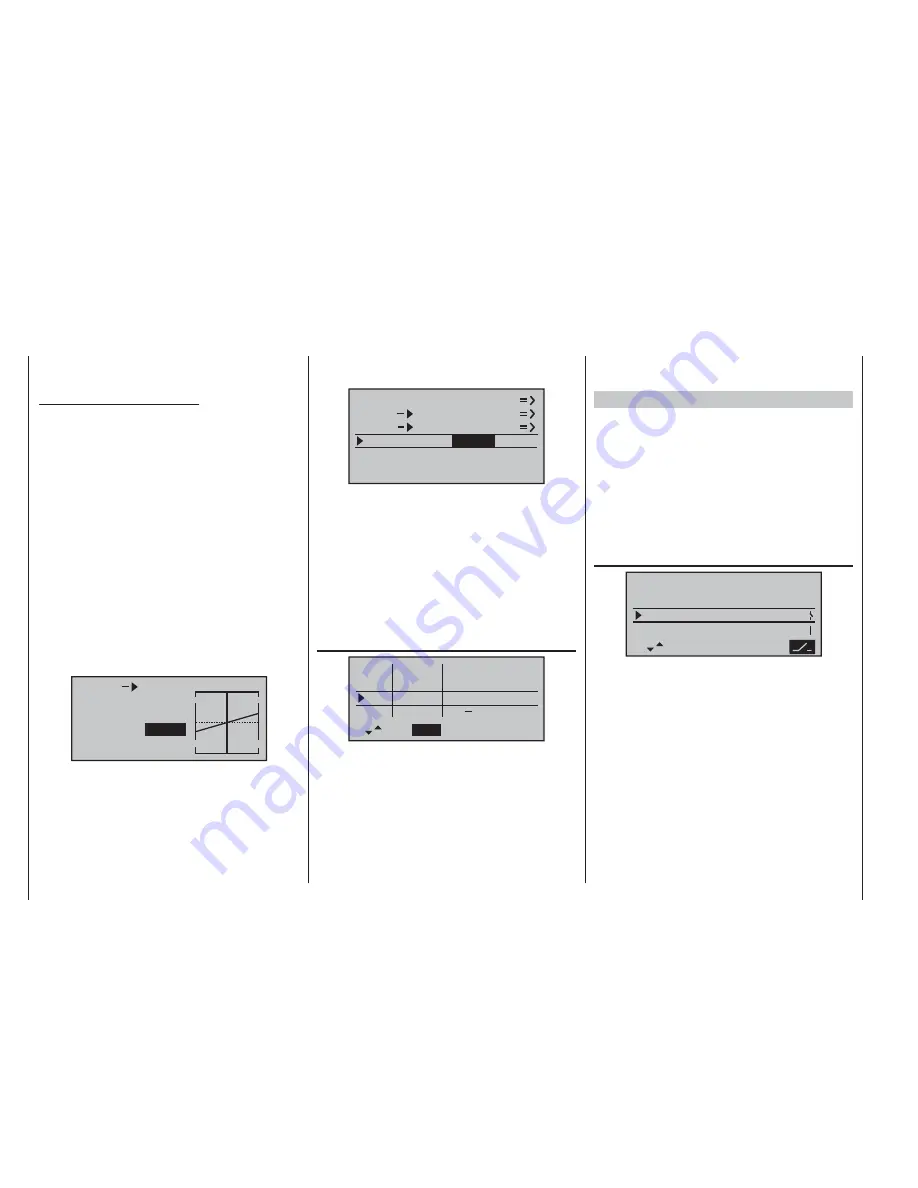
120
Programming example: model helicopter
should be changed to a value which provides a reliable
idle.
Set-up note for electric helicopters:
Since the motor must be stopped completely if an emer-
gency occurs with an electric-powered model helicopter,
this setting can be adopted unchanged.
At present the remaining sub-menus are of no interest.
Simply switch “Auto-rotation” off, and move back to the
fi rst menu list.
Call up the set-up page of the “ch1
¼
tail (rotor)” menu:
this is where you set static torque compensation (DMA)
for the tail rotor. Once again, please restrict yourself
to the three default reference points; everything else
is the preserve of the experienced pilot. For the initial
set-up – intended for a heading-lock gyro system – the
uniform pre-set values of 0% should be changed to
-30% at Point 1 (collective pitch minimum) and +30%
at the opposite end, Point 5 (collective pitch maximum),
although you may fi nd it necessary to adjust the settings
slightly later:
3
0%
0%
0%
tail
ch1
input
output
point
normal
Now switch back to the auto-rotation phase for a mo-
ment. The set-up curve is disabled here, with the result
that the tail rotor servo no longer responds to collective
pitch commands (when the main rotor is not powered,
there is no torque to be corrected).
The – static – pre-set of the gyro effect principle (“nor-
mal” or “heading lock” mode), and also the gyro gain can
now be altered by setting a value other than “0” in the
“Gyro” line:
ch1
ch1
ptch
thro
tail
normal
gyro
SEL
inp8
0%
0%
Please be sure to read and observe the set-up instruc-
tions supplied with your gyro at this point, otherwise
there is always a possibility that your helicopter will be
uncontrollable!
If your gyro features gain control from the transmitter
– unlike the model we are using in this example – you
will need another free proportional control for it, e. g. the
INC / DEC button CTRL 5. This can be assigned to the
“Gyro” input in the …
»contr set.«
menu.
(page 60)
I5
+
t r v
100%
100%
100%
100%
100%
100%
SEL
SYM
ASY
c t r l 5
e m p t y
+
+
+
+
+
+
thr
gyr
e m p t y
Hold the button pressed forward; the beep sound will
rise steadily. When it falls silent, move to the
ASY
fi eld in
the “Travel” column using the rotary cylinder. Press the
rotary cylinder, and you will be able to set a maximum
gyro gain such as 50% in the now highlighted fi eld; this
represents a safe fi xed value which is maintained as
long as the button is at its forward end-stop. You will
probably need to adjust the value in the course of fl ight-
testing.
Additional notes on setting up gyros can be found on
page 81.
Further adjustments
If you have followed this programming example, you will
have a helicopter which is set up properly, and in an
ideal state for hovering practice and simple circuits. Of
course, you may wish to activate further functions de-
pending on your skill and fl ying experience. If you wish
to fl y using different rotor speeds and trim set-ups, you
will need to activate a series of “fl ight phases”, which
can be called up via switches which you assign. The fi rst
step in this process is to call up the …
»base sett.«
(page 50 … 54)
0:00
G3
SEL
3
2
pitch min
clock
front
phase 2
hover
autorotat.
… menu, assign a switch to “Phase 2”, e. g. SW 2, and
enter a relevant name (if you wish).
It is important to be quite clear in your mind that auto-
rotation always has absolute priority over any other
phases. This simply means: if you operate the auto-ro-
tation switch, you immediately move to the auto-rotation
phase from either of the other two fl ight phases (“nor-
mal” phase and “phase 2”).
Now move back to the »
heli mixer
« menu, switch to
“Phase 2” (which you have just set up), and modify the
settings accordingly. Since the
mx
-16iFS features digital
trims, in the Heli program all the trim positions for the
control functions “roll”, “pitch-axis” and “tail rotor” are
stored separately for each fl ight phase, in addition to the
Summary of Contents for mx-16 ifs
Page 1: ...mx 16 Programming Manual mx 16iFS 1 gb 3D CYLINDER ROTARY SELECT INTELLIGENT FREQUENCY SELECT...
Page 15: ...15 For your notes...
Page 31: ...31 For your notes...
Page 35: ...35 For your notes...
Page 39: ...39 For your notes...
Page 55: ...55 For your notes...
Page 65: ...65 For your notes...
Page 77: ...77 For your notes...
Page 104: ...104 For your notes...
Page 111: ...111 For your notes...
Page 128: ...128 For your notes 128...
Page 129: ...129 For your notes 129...
Page 130: ...130 For your notes...



























